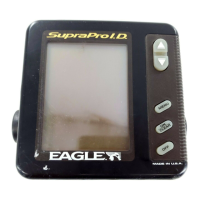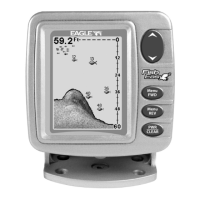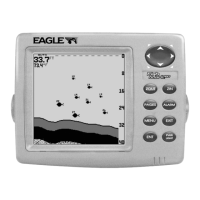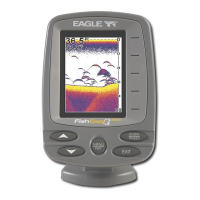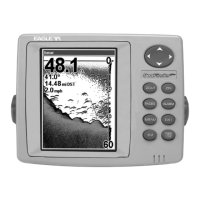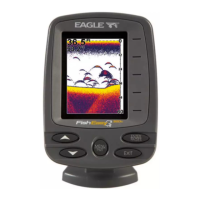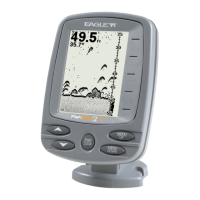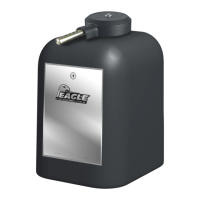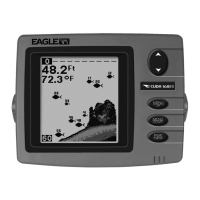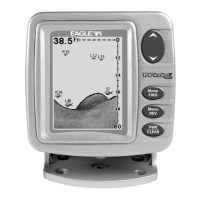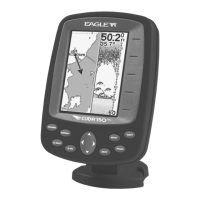With
high sensitivity settings,
a second bottom echo
(second echo) may
appear.
This is normal. It's caused
by
the
returning signal reflecting
off
the surface
of the water. Then it makes a second
trip
to the bottom and
back
again.
Remember,
when
the unit's automatic feature is
on,
the receiver's sen-
sitivity automatically adjusts
to the
surrounding
conditions. The micro-
computer places
it
at a level
slightly
above the minimum
required
to
pick
up
the bottom
signal. However,
ft's
possible
to
change
the
sensitivity
level while
the unit is
in
automatic. This
may
be desirable if the sensitiv-
ity
level is not
high
enough
to show fish or other small detail. The unit
will increase the
sensitivity
to
pick up
the bottom
signal,
then add in the
level
you programmed.
To
adjust
the
sensitivity
while the unit is in
automatic, simply press
the
SENS.
key.
Then
press
either the
up
arrow
key
to increase
it,
or the
down arrow
key
to decrease it. As
you press
the arrow
key,
the
sensitivity
bar moves
up
or
down, according
to the
sensitivity
level
chosen.
You can
adjust
the
sensitivity
in the same manner when the unit is in the
manual mode.
Both 8
degree
and
20
degree
transducers
give
accurate bottom read-
ings,
even
though
the bottom
signal
is much wider on the 20
degree
model.
This is because
you
are
seeing
more of the bottom. Remem-
ber,
the shallow
edge
of the
signal
shows
you
the true
depth.
The rest
of the
signal
tells
you
whether
you
are over
rocks, mud,
etc.
SIGNAL INTERPRETATION
Your unit
gives
an accurate
picture
of the bottom that
your
boat is
pass-
ing.
A bottom of firm
sand,
gravel,
shell,
or
hard
clay
returns a wide
bottom
signal.
If the
automatic feature is off and the bottom
signal
nar-
rows
,
then it means that
you
have moved
over a mud bottom. Mud
absorbs
the sound wave and returns a weak
signal.
Turn
up
the
sensitivity
to see a better bottom
signal.
Big
rocks or
stumps
on a smooth bottom send back
signals
above the
bottom level
signal.
The
height
of the
signal depends
on the
target's
height.
As
you pass
over a
post,
it should be
clearly
visible as a short
line
extending
above
the bottom
signal.
A
steep slope
returns a wide
signal,
the
steeper
the wider.
Signals
returned from
a
high
underwater cliff are
usually
the widest of all.
Brush
usually
lies on the bottom and shows
up
as
clumps rising
above
the bottom
signal.
Brush
signals
look similar to
large
rocks;
however
their
signal
is not as
strong
as rock.
FISH ARCHES
Fish arches are created when the cone of sound
passes
over
a fish.
The distance to a fish when the cone first
strikes ft is shown as
"A"
on
the next
page.
When the center of the cone strikes the
fish,
the
distance is
shorter,
as shown
in "B".
As the cone leaves the
fish,
the
distance
increases
again
as shown in "C".
When the Fish l.D.
feature is
off,
the
depth
of the water will affect the
size
and
shape
of the fish arch due to the cone
angle
diameter. For
example,
if
the cone
passes
over a fish in shallow
water,
the
signal
displayed
on the unit
may
not arch at all. This is due to the narrow cone
diameter and
the resolution limitations of the
display.
8
21
PDF compression, OCR, web-optimization with CVISION's PdfCompressor
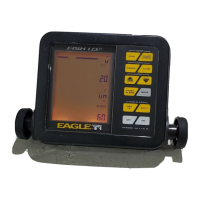
